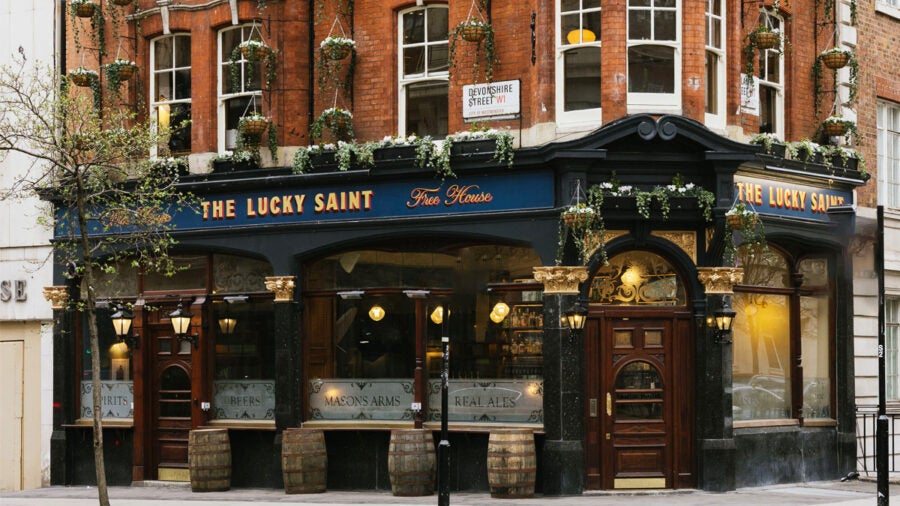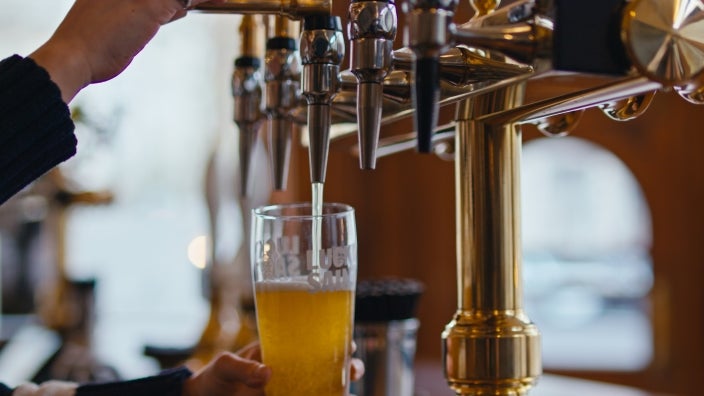
After four-and-a-half years of sharing co-working spaces, Lucky Saint, the alcohol-free beer brand, finally has somewhere to call its own: a pub.
Aptly named The Lucky Saint, the startup has renovated the former site of The Mason’s Arms in Marylebone, a four-storey, red-brick, regency terraced building that curves around the corner of Devonshire Street.
The ground floor is a text-book traditional pub: dark wood panelling, a grand bar, etched mirrors and a mix of benches and stools. The first floor has an elegant, cream-carpeted function room. The top two floors serve as the company’s new head office.
“It’s never been easier to go for a drink after work,” jokes Kerttu Inkeroinen, Lucky Saint’s director of marketing and ecommerce.
Moving into the mainstream
The Lucky Saint pub is fully licensed, but its main point of difference is the diverse range of non-alcoholic options available, including, of course, the company’s flagship lager, which takes pride of place on draught. “Draught is always better,” says Inkeroinen, sipping her pint.
Founded by Luke Boase in 2018, Lucky Saint has ridden the rise of non-alcoholic beer from niche produce into the mainstream. The company has recorded sales revenue growth of 180% year on year since launching.
It’s got to look like a beer, feel like a beer and taste like a beer. It’s got to be credible and deserve its place on the taps
It also secured more than £10m in Series A funding led by JamJar Investments, the private equity fund attached to Innocent Drinks, and Beringea VCT. The round is the largest raised by an alcohol-free beer brand in Europe.
Lucky Saint is available in 5,000 pubs, bars and restaurants in the UK – including 60 Michelin-starred venues. It is stocked by major retailers such as Waitrose, Sainsbury’s, Tesco, Marks & Spencer and Ocado. Next on the agenda, Inkeroinen tells Raconteur, is making Lucky Saint readily available in sports or music venues.
Inkeroinen, who joined Lucky Saint in September last year, believes the non-alcoholic drink market is having “a moment”. People are becoming increasingly health-conscious, she explains, but “still have the urge to be social.” Inkeroinen points out that Lucky Saint lager is just 53 calories per pint.
Where having a non-alcoholic offering might have previously been an afterthought for publicans, Inkeroinen believes that any venue that now fails to cater for this audience is actively “missing out”. Research by KAM, a hospitality consultancy firm, found that one in three pub visits in the UK does not involve ordering an alcoholic drink, while 55% of the UK adult population have indicated that they are looking to moderate their alcohol consumption in the next 12 months.
Another study, by alcohol education charity Drinkaware, found that alcohol consumption among young people has particularly slowed. It found that 16 to 25-year-olds are the most likely age group in the UK to be teetotal, with 26% not drinking alcohol, compared to the least likely age group (55 to 74-year-olds).
Inkeroinen says Lucky Saint is aware of Gen Z drinking habits but does not feel it is wise to focus company strategy on appealing to a single demographic. “Our idea is to be an option for everyone,” she says.
Growing a brand
Dry January, an annual campaign promoting abstinence from alcohol for the first month of the year, estimates it had around 10m UK participants in 2023. This year, Lucky Saint became the first official brand partner of the campaign, which is organised by the charity Alcohol Change UK.
“That was a big step for us in terms of brand building,” reflects Inkeroinen, who previously worked for Union Coffee and Coca-Cola. “I think it was really important for us to get the ‘official’ label. We went big on advertising and with experiential tasting drives. Tasting is believing, right?”
We want people to just order a Lucky Saint, almost on instinct
It is. Lucky Saint, which is brewed in Germany, offers a crisp, unfiltered taste of pale malts with a slightly gassy, hoppy edge. Although liking or disliking the taste will obviously depend on the individual, there is no questioning that Lucky Saint does taste like a beer. “We’ve always been clear that it’s got to look like a beer, feel like a beer and taste like a beer. It’s got to be credible and deserve its place on the taps.”
Being available on draught, Inkeroinen says, is a core part of Lucky Saint’s strategy. “It’s not just that it tastes better, but I think people like the feel of having a pint glass in their hand. They can get a Lucky Saint and not feel like they’re the odd one out. There is, unfortunately, still a bit of stigma around this, but here you’ve got a chance to overcome that with no questions asked.”
Lucky Saint aspires to have the same dominance in the alcohol-free space as Guinness has in the stout market. “If someone wants a stout,” Inkeroinen says, “they’re not asking for a stout, are they? They ask for Guinness, because Guinness has done such a good job of being the go-to brand for that kind of drink. That’s what we want to be for non-alcoholic beers. We want people to just order a Lucky Saint, almost on instinct.”
Normalising moderation
Inkeroinen, and many of the circa 60 Lucky Saint staff, do drink alcohol themselves. Lucky Saint, she stresses, has never set out to be an anti-alcohol movement. “In fact,” she says, “one of the best bits of feedback I’ve ever had from customers is a woman telling me that she likes us because we’re not preachy.”
The key message behind Lucky Saint, according to Inkeroinen, is “all about choice. It’s why The Lucky Saint is fully licensed. We want a group of friends to be able to have a night out and if some want to drink, that’s OK. If some doesn’t want to drink, that’s also OK. But the point is that the ones who don’t drink still get to have a great taste. They’re not compromising on anything.”
When it comes to advertising and awareness Lucky Saint’s current focus appears to be on placement. “Right now,” Inkeroinen says, “it’s about making sure that we are getting in the right positions, so people can see us and try us.”

Inkeroinen is mindful of the language that Lucky Saint uses in its advertising. “We don’t want to try and be ‘beer without the hangover’, for example, because then people might think we are missing something.”
It’s not that people would want a hangover, she clarifies, but more that Lucky Saint doesn’t want to do anything to “other” the brand. “There shouldn’t be a distinction between Lucky Saint and ‘normal’ beer,” Inkeroinen says. “It’s important for us to be normalised as a beer.”
As for endorsements, Inkeroinen offers a word of warning for any business trying to artificially elevate its image. “People can see through celebrity endorsements if they are insincere,” she notes. “We have celebrities who drink Lucky Saint and they might post about us [on social media]. Will Greenwood [the former rugby union player] is a fan. But we would need to think carefully about just asking people to start promoting us… it’s not as simple as just handing someone money. We want support to be organic, and because people actually want to support us.”
How much does Lucky Saint cost?
Should Lucky Saint be cheaper than an alcoholic drink? “It’s tricky,” says Inkeroinen, who suggests that a pint of the non-alcoholic lager should retail at, depending on the venue and its location, between £5 to £6.50. The average cost of a pint of beer in the UK is £3.95. “But it actually costs more to make non-alcoholic beer than it does to make alcoholic beer,” Inkeroinen claims.
Inkeroinen wants Lucky Saint to be viewed as a premium product. “Our beer tastes good,” she insists. “A lot of skill goes into making it. I think the moment you start making it a lot cheaper, you run the risk of people thinking it is an inferior product. We don’t want that.”
Inkeroinen’s enthusiasm for her brand is admirable, but surely there is the context of the cost-of-living crisis to be appreciated. If Lucky Saint wants to reach the largest possible market, a more accessible pricing point could help to present it as an attractive alternative to alcoholic lagers.

Lucky Saint, in this reporter’s view, definitely tastes better than Carling, Foster’s, Heineken, Carlsberg and many other alcoholic beers. Yet a pint of Carling is available, even in London, for under £2.
While trading on taste alone might be an ideal, eventual scenario, there is a challenge in people’s perception of cost versus value that needs to be overcome first. People, presently, begrudge overpaying for a soft drink or an alcohol-free beer. If the choice to stay sober is priced prohibitively, there is a very real possibility that customers, who still crave the act of socialising as Inkeroinen herself notes, will just continue to drink what they can afford.
Planning for the future
Although there may be some creases to be ironed out, it does seem like Lucky Saint is moving in the right direction. The company is certified as a B-Corp and appears to be climate-conscious. It also appears to be a progressive employer, with a diverse senior leadership team and very visible strategies around staff health and wellbeing.
As the alcohol-free market matures, Inkeroinen says, Lucky Saint wants to shed its startup tag and join “the big boys” as a staple of UK pub taps. To do that will require time, investment and, probably, some bold, empowering advertising campaigns. And that’s where she comes in.

After four-and-a-half years of sharing co-working spaces, Lucky Saint, the alcohol-free beer brand, finally has somewhere to call its own: a pub.
Aptly named The Lucky Saint, the startup has renovated the former site of The Mason’s Arms in Marylebone, a four-storey, red-brick, regency terraced building that curves around the corner of Devonshire Street.
The ground floor is a text-book traditional pub: dark wood panelling, a grand bar, etched mirrors and a mix of benches and stools. The first floor has an elegant, cream-carpeted function room. The top two floors serve as the company’s new head office.
